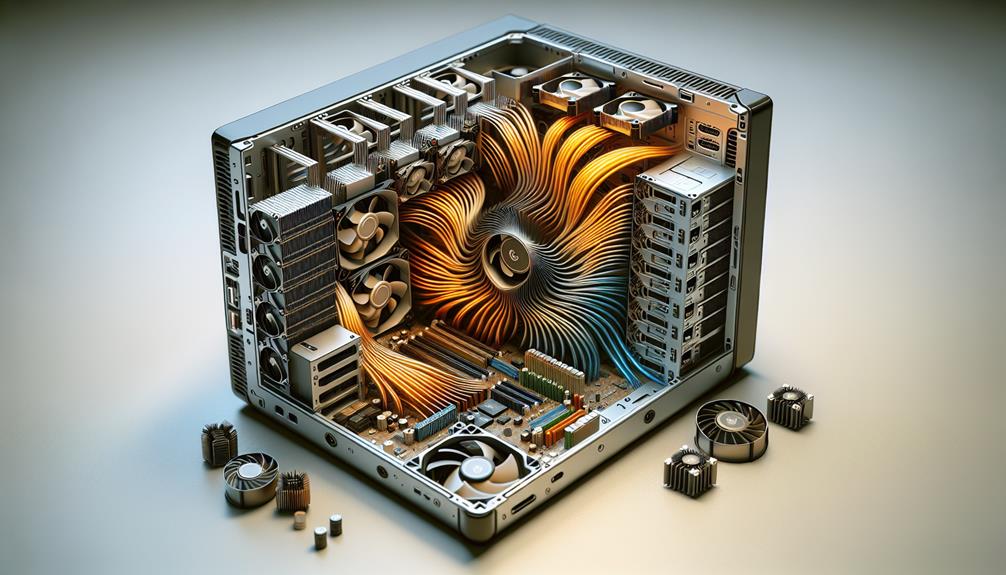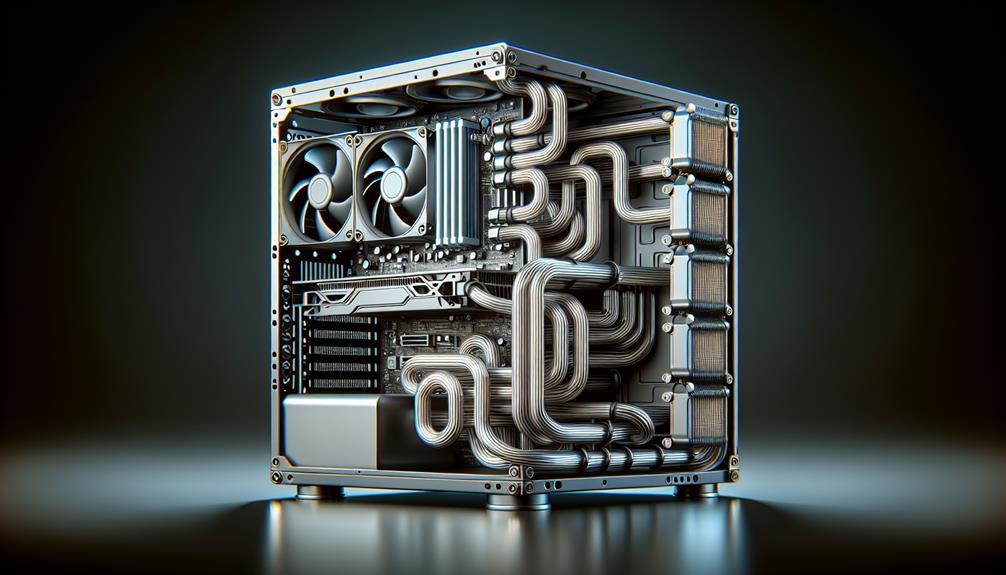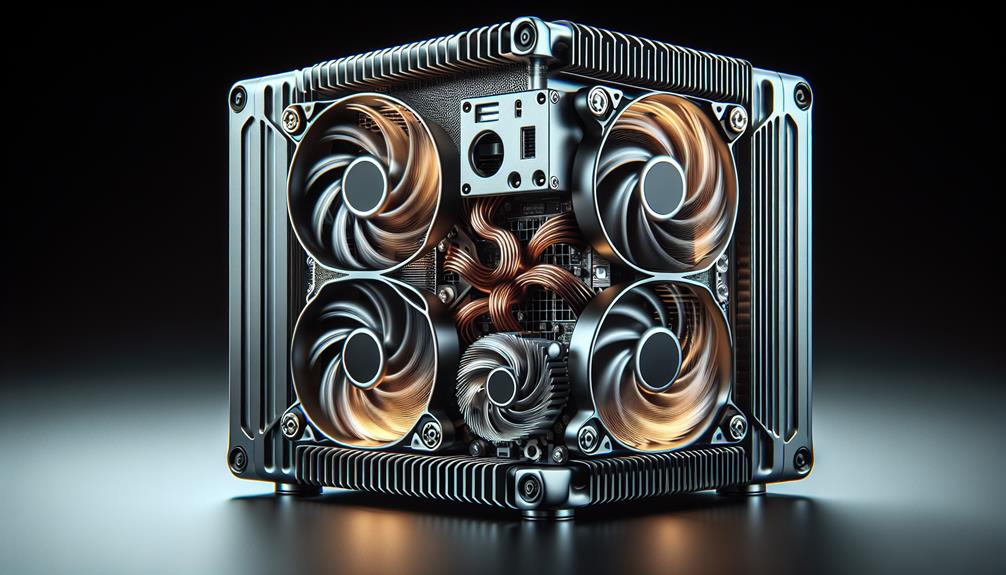



Mini PCs handle heat dissipation through strategic fan placement, passive cooling methods, and optimized thermal conductivity. They utilize high-quality materials like copper and aluminum for heat spreaders and employ intricate heat sink designs. By managing ventilation, airflow, and utilizing liquid cooling solutions, they enhance heat transfer efficiency. Mini PCs implement heat pipes, vapor chambers, and thermal interface materials for uniform heat distribution. Best thermal paste application and selection improve overall heat management. Overclocking impacts heat dissipation, necessitating advanced cooling solutions. Case design innovations focus on efficient airflow and heat dissipation. Understanding these techniques guarantees top performance and longevity in mini PCs.
Key Takeaways
- Strategic component placement optimizes heat dissipation.
- Efficient fan design enhances airflow for cooling.
- Utilize heat sinks and heat pipes for effective cooling.
- Incorporate thermal interface materials for heat transfer.
- Implement advanced thermal management features in case design.
Efficient Cooling Systems
To efficiently cool a mini PC, prioritize the placement of fans and optimize airflow within the compact chassis. Passive cooling techniques such as thermal insulation play an important role in managing heat within confined spaces. By strategically placing insulation materials in key areas, heat dissipation can be improved without the need for active cooling components.
Additionally, thermal conductivity optimization is essential in mini PC design. Heat spreaders made of materials with high thermal conductivity help to distribute heat evenly across components, preventing hotspots and potential damage due to overheating. These heat spreaders efficiently transfer heat away from critical components towards areas with better airflow or cooling solutions, enhancing the overall thermal performance of the system.
Heat Sink Technology
Implementing advanced heat sink technology enhances the thermal management capabilities of mini PCs, optimizing heat dissipation efficiency in compact systems. Heat sink development plays an essential role in dissipating heat generated by the components within a mini PC. Manufacturers are constantly innovating in the design and materials used for heat sinks to improve overall performance.
One key aspect of heat sink technology is the use of high thermal conductivity materials. These materials, such as copper and aluminum, are efficient at transferring heat away from the source and spreading it across a larger surface area for dissipation. By incorporating these materials into the heat sink design, mini PCs can effectively manage heat buildup in confined spaces.
Advancements in heat sink development have led to the creation of intricate fin patterns and heat pipe designs that further enhance thermal conductivity. These innovations help in maximizing the heat transfer capabilities of the heat sink, ensuring that mini PCs can operate at best temperatures even under heavy workloads.
Thermal Design Considerations

In considering thermal design for mini PCs, the focus shifts towards optimizing heat dissipation through strategic component placement and airflow management. Heat dissipation strategies play a pivotal role in ensuring performance optimization and maintaining thermal management for enhanced component longevity.
Efficient thermal design involves strategically placing heat-generating components to facilitate natural convection or airflow from cooling fans. By positioning components such as the CPU, GPU, and power supply unit strategically, heat dissipation can be improved, reducing the risk of thermal throttling and ensuring consistent performance.
Moreover, thermal management techniques like heat spreaders, heat pipes, and thermal pads help in transferring heat away from critical components to heat sinks or areas with better airflow. These strategies aid in maintaining ideal operating temperatures and contribute to the longevity of the components by reducing thermal stress.
Ventilation and Airflow Solutions
Efficiently managing ventilation and airflow is essential for optimizing heat dissipation in mini PCs. Airflow optimization plays a pivotal role in thermal management and cooling strategies for these compact systems. To enhance heat dissipation, mini PCs are designed with carefully engineered ventilation systems. These systems often include strategically placed vents and fans to guarantee proper airflow circulation within the device.
Heat dissipation techniques in mini PCs rely heavily on effective airflow management. By directing airflow over key components such as the CPU and GPU, heat is efficiently drawn away from these heat-generating parts. Additionally, thermal management solutions involve utilizing heat sinks and heat pipes to further aid in cooling.
Cooling strategies in mini PCs encompass a comprehensive approach that considers factors like component layout, fan placement, and airflow direction. Manufacturers continually refine these strategies to achieve optimal cooling performance while maintaining the compact size and portability of mini PCs. Overall, ventilation and airflow solutions are fundamental in the successful heat dissipation of mini PCs.
Liquid Cooling Solutions

When considering heat dissipation in mini PCs, liquid cooling solutions offer a highly effective method for managing thermal loads. Water cooling options provide superior heat transfer capabilities compared to air cooling. Radiator placement plays an essential role in optimizing heat dissipation efficiency. Coolant circulation is key to ensuring that heat is effectively transferred away from the components. The efficiency of the pump in liquid cooling systems is vital for maintaining proper coolant flow and heat transfer rates. By using liquid cooling solutions, mini PCs can achieve better thermal management, allowing for improved performance and longevity of the components. Properly designed liquid cooling setups can effectively dissipate heat from high-performance components in a compact form factor, making them ideal for mini PCs where space is limited. Consider incorporating liquid cooling solutions in your mini PC build to enhance its thermal performance and overall reliability.
Heat Pipes and Vapor Chambers
Utilizing heat pipes and vapor chambers enhances heat dissipation efficiency in mini PCs. Heat pipes are highly efficient at transferring heat due to their ability to quickly conduct heat away from the heat source. This efficiency is achieved through the phase change of the working fluid inside the heat pipe, which facilitates the rapid transfer of thermal energy. Heat pipes are commonly used in mini PCs to direct heat away from hot components such as the CPU or GPU towards cooling elements such as heatsinks.
Vapor chambers, on the other hand, offer benefits such as improved heat spreading and higher heat transfer capacity compared to traditional heat pipes. Vapor chambers consist of a sealed chamber containing a small amount of water that vaporizes and spreads the heat evenly across its surface. This feature allows vapor chambers to effectively dissipate heat from hotspots on mini PCs, ensuring uniform temperature distribution and enhanced cooling performance. By incorporating heat pipes and vapor chambers, manufacturers can optimize heat dissipation in mini PCs, maintaining ideal operating temperatures for improved performance and longevity.
Fan Design and Placement

For vital heat dissipation in mini PCs, attention to fan design and placement is essential. Fan efficiency plays a critical role in making sure that heat generated by the components inside the mini PC is effectively dissipated. The design of the fan blades, motor, and overall airflow management all contribute to how efficiently heat can be expelled from the system.
Proper placement of fans within the mini PC chassis is equally important. Fans should be strategically located to create ideal airflow patterns that help in carrying heat away from critical components. Intake fans draw in cool air, while exhaust fans expel the hot air, facilitating the heat dissipation process. Additionally, the size and number of fans used should be carefully considered to guarantee sufficient air circulation without causing unnecessary noise.
Thermal Interface Materials
To optimize heat dissipation in mini PCs, understanding the importance of thermal interface materials is essential. Thermal interface materials play a significant role in heat dissipation optimization by facilitating the transfer of heat between components and heat sinks. One key factor to take into account is thermal conductivity, which measures the material's ability to conduct heat.
When applying thermal paste, make sure a thin and uniform layer to maximize heat transfer properties. Proper application helps fill microscopic imperfections on the surfaces, improving the contact between the components and the heat sink. This promotes efficient heat dissipation and prevents overheating issues in mini PCs.
Selecting high-quality thermal interface materials with excellent thermal conductivity is crucial for effective heat management in mini PCs. These materials enhance the overall thermal performance of the system by minimizing thermal resistance at the interface points. By understanding the significance of thermal interface materials and their impact on heat dissipation, you can guarantee efficient thermal management in mini PCs.
Overclocking and Heat Management

Understanding the impact of overclocking on heat management is pivotal in optimizing the performance of mini PCs. Overclocking can provide significant performance benefits by pushing the processor beyond its rated speed, but it also generates more heat in the process. To effectively manage the increased heat produced during overclocking, various heat dissipation techniques can be employed.
One common method is to use high-performance cooling solutions such as liquid cooling systems or advanced air cooling setups. These solutions help dissipate the heat generated by the overclocked components more efficiently, thereby preventing thermal throttling and ensuring stable performance.
Additionally, optimizing the airflow within the mini PC case is vital for effective heat management. Properly placed fans and ventilation channels can help maintain lower operating temperatures, especially when the system is under heavy load due to overclocking.
Mini PC Case Design Innovations
Innovative mini PC case designs incorporate advanced thermal management features to enhance heat dissipation efficiency. Customizable aesthetics play an important role in these designs, allowing users to personalize the appearance of their mini PCs while maintaining ideal thermal performance. By integrating sleek exteriors with functional airflow patterns, manufacturers can offer a balance between style and functionality.
Space-saving design is another key aspect of these innovative mini PC cases. Through clever engineering and utilization of compact components, these cases maximize internal space utilization while ensuring efficient heat dissipation. This design approach not only contributes to a smaller footprint but also aids in maintaining lower operating temperatures for the internal hardware components.
Disclosure: As an Amazon Associate, I earn from qualifying purchases.






